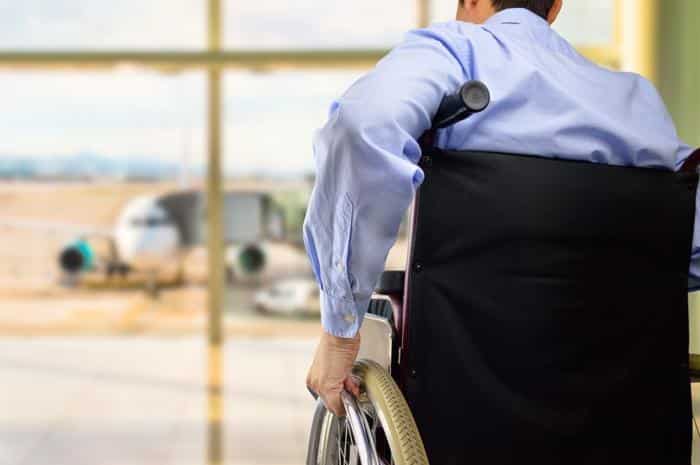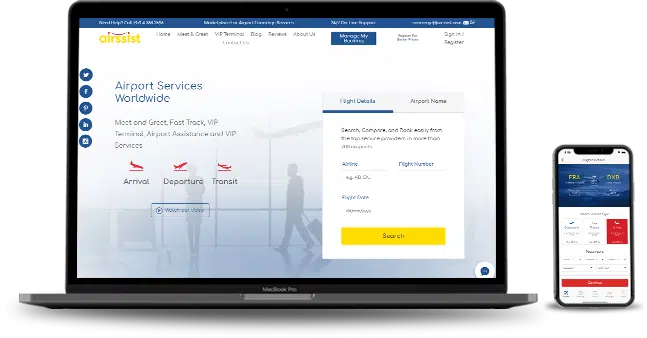Table of Contents
It’s not like catching a flight is easy for anyone, but for individuals with disabilities, the challenges can multiply fast. Airport Assistance for Disabled Travelers is essential that one might possibly think to make a difference at airports while also respecting every traveler’s comfort and independence. In 2025, over 52% of adults with disabilities in Canada took air trips, yet 40% faced at least one major barrier at the airport, from lack of support services to simply not knowing how to request help. People with mobility, sensory, or cognitive difficulties often find moving in terminals, security lines, or even boarding gates a daunting task. That’s why specialized airport assistance, ranging from wheelchair support to visual or auditory guidance has become a lifeline. In this blog, we’ll explore the types of services available, common challenges and how to overcome them, and which airports are leading the way in accessibility, so that every journey feels possible, and empowering.
Moreover, you’ll understand the value of airssist at airports and how our VIP services can transform a life changing travel experience to the needy.
What Is Airport Assistance for Disabled Travelers?
Airport Assistance for Disabled Travelers is incredibly important for ensuring that the airport experience is accessible, safe, and manageable for those who need a little extra help. Whether someone has a mobility issue, visual impairment, or a medical condition, this service makes sure that passengers aren’t left to navigate the airport on their own. Airlines are obligated to provide timely and dependable assistance, which includes wheelchair support, guided movement, and help with check-in, security, and boarding. However, to access this support, passengers need to let the airline staff know at the airport that they require assistance.
This airport assistance service is designed to assist travelers at every step of their airport journey. It starts from the terminal entrance or drop-off area and continues all the way to their seat on the plane. For those with connecting flights, the help carries on from one gate to the next, and once they arrive, passengers receive support until they reach baggage claim or their designated pickup point. Assistance is also necessary in key areas like ticket counters, restrooms, and baggage claim. If a traveler is unable to carry their bags due to a disability, airline staff are required to lend a hand.
A traveler from Denmark, shared her experience on TripAdvisor, expressing her anxiety about the uncertainty of wheelchair services at major airports. She needed assistance all the way to the aircraft door but felt discouraged by the confusing booking policies. “This uncertainty is too stressful for me, if I can’t rely on wheelchair assistance, I won’t fly,” she said. Her experience underscores why consistent and dependable service is not just helpful it’s absolutely essential.
Legal Rights for Disabled Travelers
The Right to Be Treated with Dignity and Respect
Airlines and their staff, including contractors, must not discriminate against passengers based on any physical, mental, or sensory disability. This means that individuals with disabilities cannot be denied services or boarding simply because of their appearance, involuntary behavior, or the condition they have. Passengers shouldn’t be pressured into accepting assistance they didn’t request, like a wheelchair when they only need help with navigation. It’s crucial that airline personnel receive training on how to assist travelers with disabilities in a respectful and safe manner, with mandatory refresher courses every few years. This right guarantees that all passengers are treated equally and aren’t subjected to unnecessary limitations during their travels.
The Right to Receive Accessible Information
Travelers with disabilities should have access to the same information as everyone else, but in a way that works for them. Airlines are required to ensure their websites are accessible and that at least 25% of airport kiosks cater to individuals with visual or hearing impairments. Information at gates, customer service desks, and on planes must be provided in an accessible format, like writing things down, using large print, or Braille when possible. Staff should also be ready to assist passengers who are deaf, hard of hearing, or visually impaired using straightforward communication methods. This way, all passengers can stay informed and empowered, regardless of how they receive information.
The Right to Airport and Aircraft Assistance
From the moment you’re dropped off at the curb to when you finally settle into your seat, passengers with disabilities have the right to receive prompt and trained assistance throughout the airport. This support includes help with navigating ticket counters, security checks, and gates, as well as during layovers. Once you arrive, the assistance doesn’t stop; it continues all the way to baggage claim or wherever you need to be picked up. If you’re using a wheelchair or any mobility aid, airlines are required to ensure you’re not left unattended for more than 30 minutes unless you’ve agreed to it. The aim is to make every step of your airport journey accessible and as stress-free as possible.
The Right to Travel with Assistive Devices and Service Animals
Passengers are allowed to bring wheelchairs, walkers, medical devices, and other assistive tools on board without any extra charge. These items won’t count against your carry-on limit and should ideally be stored in the cabin. If they need to go in the cargo hold, airlines must take care of them and ensure they’re returned to you at the gate. If anything gets damaged or lost, you’re entitled to compensation. Service dogs are also covered by the law and can accompany you in the cabin, as long as they’re well-behaved and don’t pose a safety or comfort risk. These regulations are in place to ensure that travelers can bring along what they need to stay independent and safe.
The Right to Accessible Aircraft Features
When it comes to aircraft, certain accessible features are a must, depending on the size of the plane. For instance, any aircraft with 30 or more seats is required to have movable aisle armrests. If the plane has over 100 seats, it must also provide cabin storage space for a wheelchair. Larger twin-aisle aircraft should include an accessible lavatory and an onboard wheelchair as well. These features are crucial for ensuring that passengers with mobility challenges can navigate the cabin safely and comfortably, whether they’re on a quick hop or a long-haul flight.
The Right to Seating Accommodations
Passengers with disabilities who require specific seating for medical or accessibility reasons should be prioritized when it comes to seat assignments. This means aisle seats with movable armrests, bulkhead seats for those traveling with service animals, or seats with extra legroom for individuals with conditions like a fused leg. It’s also important that companions who provide essential services—such as interpreters or personal care attendants—are seated close by. Airlines utilize one of three approved seating methods (block, priority, or pre-boarding) to accommodate these needs, ensuring that everyone has a safe and supportive seating experience.
The Right to Resolution
If something goes awry during your travels, airlines are obligated to provide immediate access to a Complaint Resolution Official (CRO)—a trained expert who can tackle disability-related issues right then and there. Every airport that an airline serves must have a CRO on hand during operational hours. Passengers also have the option to file formal complaints with the airline or the U.S. Department of Transportation (DOT), which are required to be addressed within 30 days. This system ensures that travelers don’t feel helpless when their needs aren’t met and promotes accountability throughout the travel industry.
Other federal laws and Regulations for Disabled Travelers
Ensuring Compliance with the Air Carrier Access Act (ACAA) for Disabled Travelers
This U.S. federal law prohibits discrimination against individuals with disabilities in air travel. It requires airlines to provide assistance and accommodations to passengers with disabilities, including wheelchair services and other necessary support during their journey.
Understanding European Union Regulations for Disabled Travelers
In the European Union, Regulation (EC) No 1107/2006 establishes the rights of disabled persons and persons with reduced mobility when traveling by air. It mandates that airports and airlines must provide assistance to these individuals, including wheelchair services, free of charge.
Compliance with ICAO Guidelines for Disabled Travelers
The ICAO provides guidelines on the facilitation of passengers with disabilities to ensure uniformity and best practices across different countries. These guidelines cover various aspects of disability assistance, including wheelchair services, training for staff, and proper handling of mobility aids.
Ensuring Compliance with Airport Accessibility Regulations for Disabled Travelers
Many countries have specific regulations or guidelines that airports must adhere to regarding accessibility for individuals with disabilities. These regulations may cover areas such as wheelchair accessibility, signage, accessible restrooms, and designated assistance points.
In short, it’s important for airport service providers to comply with these regulations and guidelines to ensure that individuals with disabilities receive the necessary assistance and support during their travel experience. Compliance helps to create an inclusive and accessible environment for all passengers, regardless of their mobility challenges or disabilities.
Types of Airport Assistance Services for Overcoming Challenges Faced by Disabled Travelers
1. Personalized Meet and Greet Services
There’s nothing quite like the feeling of being greeted at the airport by a friendly assistant who’s already in tune with your needs. Whether you’re traveling alone, trying to find your way through a bustling foreign airport, or just need a little extra help, meet and greet services are your go-to support. You’ll be welcomed by name and guided through every step of your airport journey, from the entrance to check-in, through security, and all the way to your boarding gate. This service is particularly beneficial for visually impaired travelers, elderly passengers, or first-time flyers who may have mobility issues.
Benefit: It takes the stress out of traveling, saves you time, and adds a personal touch to every part of your airport experience.
Wheelchair Assistance and Mobility Support
Whether you bring your own wheelchair or need one provided at the airport, staff are there to help you through check-in, security, restrooms, boarding, and deplaning. Wheelchair services also cover transfers between flights and, in many airports, offer electric carts for those long terminal walks. However, the reliability of this service can vary.
Benefit: It allows you to navigate the airport with ease, without the worry of overexerting yourself or being left behind.
Priority Check-In and Baggage Help
Airports can be a whirlwind, especially when it comes to check-in counters. With disability support, you won’t have to juggle paperwork, manage your luggage, or figure out digital kiosks on your own. Assistance staff are there to make sure you’re checked in properly, that your baggage is handled safely, and that any special medical equipment is documented and stored correctly. For those facing dexterity or cognitive challenges, this service can truly ease the stress of travel.
Benefit: It makes the start of your journey smoother with thoughtful, human support.
Fast Track Through Security and Immigration
For travelers facing mobility or sensory challenges, standing in long lines at security or immigration can be a real struggle. That’s where fast-track lanes come in, providing a quicker, more manageable route through these checkpoints, often with a trained assistant to help you navigate the crowds. It’s not just about getting through faster, it’s about making the experience more comfortable and conserving your energy.
Benefit: Avoid long waits and sensory overload, with a peaceful transition to the gate.
Boarding and Disembarking Support
When it’s time to board or disembark from the plane, travelers with disabilities are entitled to personal assistance. This might involve help with an aisle chair, stowing your devices, or getting to your seat on board. Airlines are also obligated to provide lifts or ramps if level boarding isn’t an option. Assistance staff should never keep you waiting longer than 30 minutes, especially if you’re in a non-motorized wheelchair or need a transfer.
Benefit: Guarantees a safe, respectful, and timely boarding process, without making you feel like a burden.
Real-Time Flight Monitoring & Rebooking Help
Delays or cancellations can add extra stress, especially when you depend on scheduled assistance. Luckily, some services keep an eye on your flight status in real time. If anything changes, they’ll help you rebook, find your new gate, and even update your assistance requests. This kind of support ensures a smooth experience, no matter what surprises come your way.
Benefit: Offers peace of mind, so you won’t feel lost or alone during any disruptions.
Lounge Access & Escort Services
When you find yourself stuck at the airport for a long layover or delay, the main terminal can feel like a never-ending wait. Luckily, many assistance packages offer access to airport lounges, these cozy, quiet spots come with snacks, clean restrooms, and often, dedicated help. And when it’s time to board? An escort will be there to guide you right to the gate or even to the plane door.
Benefit: Provides a sense of comfort and tranquility during those lengthy waits and transitions, especially for anyone dealing with fatigue or anxiety.
Personalized Shopping and Language Help
Do you need a hand picking up essentials or browsing duty-free shops? Or maybe you’re looking for someone to help you navigate a language barrier? Some assistance services offer personal shoppers or multilingual guides who can help you feel more at ease and in control.
Benefit: Maximizes your airport experience, making it more enjoyable and independent, even if you’re in a foreign country.
Guide to Wheelchair Types, Assistance Levels, and Additional Services
When it comes to service descriptions for wheelchair-related services, there are various types of wheelchairs available, different levels of assistance provided, and additional services that can be offered. Let’s delve into each aspect in more detail:
Discovering Wheelchair Options for Disabled Travelers
- Standard Manual Wheelchairs: These are basic, manually operated wheelchairs that are suitable for passengers who have sufficient upper body strength and mobility to self-propel.
- Transport Wheelchairs: Also known as companion wheelchairs, these are lightweight and compact wheelchairs designed for easy transport of passengers who are unable to self-propel. They are typically pushed by airport staff or companions.
- Electric Wheelchairs: Electric wheelchairs, or power wheelchairs, are motorized wheelchairs controlled by the passenger using a joystick or other input devices. They offer greater independence and mobility for passengers with limited upper body strength or mobility.
Choosing the Right Assistance Levels for Disabled Travelers
- a. Independent Mobility: Passengers who can navigate the airport and board the aircraft independently may require minimal assistance. They may only need assistance with checking in the wheelchair and retrieving it at the destination.
- b. Attendant Assistance: Some passengers may require assistance with maneuvering the wheelchair throughout the airport, including check-in, security checkpoints, and boarding. Airport staff or trained attendants can provide the necessary support.
- c. Full Assistance: Passengers with significant physical limitations may require comprehensive assistance throughout their journey. This can include assistance with check-in, security procedures, navigating the airport, boarding, and disembarking.
Exploring Additional Services for Disabled Travelers
Airport wheelchair services may offer medical assistance for passengers who require it. This can include the presence of medical professionals or aides who can provide basic medical support or attend to specific medical needs.
It’s important to note that the availability of specific types of wheelchairs, assistance levels, and additional services can vary among airports. It’s advisable to contact the airport or airline in advance to discuss specific needs and make necessary arrangements. Airport wheelchair services are designed to ensure a smooth and comfortable travel experience for passengers with mobility challenges or disabilities.
How to Request Airport Assistance
Requesting airport assistance might feel a bit daunting at first, but trust me, it’s really a simple process. It can truly make a huge difference for travelers with disabilities or special mobility, sensory, or medical needs. Just plan ahead as below;
Book early with airssist!
Just head over to airssist.com or drop an email to [email protected] to secure your assistance at least 48–72 hours before your flight. You’ll have a variety of services to choose from, including wheelchair support, fast-track clearance, and VIP terminal access.
Let Us Know What You Need
When you’re booking, be sure to specify any mobility, sensory, or medical needs you might have. Whether it’s wheelchair assistance, visual guidance, or an escort from your car to the gate, airssist is dedicated to making sure all your preferences are taken care of.
Get Your Confirmation & VIP Coordination
The concierge team at airssist will confirm all your arrangements ahead of time, working directly with airport staff to ensure everything goes smoothly when you arrive, depart, or have a layover.
Arrive Without the Stress
A friendly greeter will be waiting for you at the vehicle drop-off or airport entrance, ready to help you navigate check-in, security, and immigration, so you can skip the long lines and any confusion.
Enjoy a Worry Free Trip
From lounge access to baggage handling and boarding assistance, airssist is there for you every step of the way, ensuring you’re fully supported and never left alone.
Essential Tips for Wheelchair and Guided Airport Assistance
- Book assistance the first ting
- Clearly mention if you need a manual or electric wheelchair, or guided help.
- Arrive 2.5–3 hours early for international flights.
- Use airssist for premium meet-and-greet and end-to-end escort services.
- Request pre-boarding access if you need extra time to settle in.
- Know that basic assistance is free, but airssist adds luxury and reliability.
- Ask for help with baggage if you can’t manage it alone.
- Don’t forget arrival assistance, airssist supports you through your ride.
- Keep medical documents and equipment details handy.
- Stay in touch with your dedicated airssist concierge for real-time support.
Other Travel Tips for Disabled Travelers
- Make sure to bring along any important documents like your doctor’s notes and prescriptions.
- Confirm that you have the assistance you need before you leave and again when you return.
- Don’t forget to pack your essential medical items in your carry-on bag.
- Take a look at airport maps ahead of time to plan your movements.
- Consider downloading accessibility apps or checking out airport-specific information.
Common Challenges & Smart Solutions
Long Waits for Wheelchair Assistance
Solution: Pre-book VIP airport concierge services like airssist, which offer guaranteed mobility assistance from curb to gate, even during peak hours.
Untrained or Unavailable Airport Staff
Solution: Opt for specialized providers who train staff in dealing with all kinds of disabilities, not just visible ones like mobility issues.
Lack of Communication and Awareness
Solution: Use disability ID cards or visual communication aids to alert staff to needs like hearing impairments, neurodiversity, or cognitive disabilities.
Inaccessible Terminals or Long Distances
Solution: Arrange for electric cart transfers or assistance with baggage through services such as airssist that coordinate these details in advance.
Invisible Disabilities Ignored
Solution: Travelers with sensory, cognitive, or psychiatric conditions should advocate for their needs through pre-arranged help and notify staff on arrival for guided assistance.
Missed Connections Due to Delays in Special Assistance
Solution: With flight monitoring and fast-track services, travelers are met at every stop, even during tight connections.
Confusion Around How to Request Help
Solution: Book your journey with a full-service platform like airssist, which streamlines all requests for assistance in one place and provides real-time updates.
Airports Leading the Way in Accessibility
Singapore Changi Airport (Score: 96/100)
Topped Halton Stairlifts’ global ranking with over 50,000 verified traveler reviews. Changi is celebrated for its well-defined assistance zones, sensory-friendly areas, help points, and the attentive support provided by staff throughout the airport.
Zurich Airport, Switzerland (Score: 94/100)
Claimed the second spot thanks to its multilingual signage, fast-track mobility services, barrier-free layouts, and consistently high traveler satisfaction regarding navigation and support.
Vancouver International Airport, Canada (Score: 88/100)
Recognized for its user-friendly accessibility features, like Braille signage, alert systems, wide walkways, and responsive staff, making it one of the most accommodating major airports
Dubai International Airport, UAE (Score: 85/100)
As the only Middle Eastern airport in the top ten, DXB shines with its 24/7 assistance teams, accessible prayer rooms, multilingual coordination, and a seamless pre-booking process for mobility support.
Emerging Technologies Enhancing Accessibility
Airports are stepping up their game by adopting cutting-edge technologies to enhance Special Assistance for disabled travelers, making their experiences smoother, safer, and more dignified. As digital accessibility continues to advance, these innovations are set to revolutionize the entire airport journey, from check-in to boarding.
Biometric Identification for Smoother Check-In
At terminals like Singapore Changi, facial and iris recognition systems allow for passport-free clearance in less than 10 seconds. This means no more fumbling with physical documents, making entry much easier, especially for those with visual, mobility, or cognitive impairments.
Autonomous Mobility Robots & Wheelchairs
Airports such as Miami International and Dublin Airport are testing out self-driving wheelchairs and AI robots that assist travelers, guide visually impaired guests, and manage luggage. This not only reduces the burden on overworked staff but also empowers passengers to navigate more independently.
Real-Time Navigation Apps with Beacon-Based Wayfinding
Major international hubs are rolling out beacon-powered indoor navigation tools and AI-enhanced digital wayfinding. These provide travelers with turn-by-turn directions, voice prompts, or haptic feedback, ideal for those facing visual or cognitive challenges.
AI-Driven Support for Hearing-Impaired Travelers
Airports are experimenting with AI chatbots and natural language processing tools that translate audio announcements into text or sign language, ensuring that deaf or hard-of-hearing passengers can stay informed and included.
These improvements are inspired by broader trends in digital accessibility, like AI-driven personalization, natural language processing, and gesture controls, now making their way from the online world into airports to enhance real-life travel experiences.
Trusted Sources for Airport Assistance Information for Disabled Travelers
Getting through an airport with a disability can feel overwhelming, but having the right information ahead of time can make the whole journey much easier and less stressful.
Government Guidelines: Stay informed about your rights and airport responsibilities with links to official resources like the Department of Transportation’s Air Carrier Access Act and the Federal Aviation Administration’s Passengers with Disabilities
Disability Advocacy Groups: Connect with communities like the National Center for Independent
Living (NCIL) and the American Association of People with Disabilities (AAPD) for valuable insights and support.
By utilizing these trusted resources, you can make informed decisions and advocate for your needs, ensuring a more confident and stress-free travel experience.
FAQs
1. Do I need to pay for airport assistance?
No! Basic airport assistance services, like wheelchair support, help navigating security, and assistance with boarding or deplaning, are usually offered for free by most airlines and airports if you ask ahead of time. However, if you’re looking for premium, personalized services or fast-track help, you might want to check out third-party providers like airssist, who offer specialized support for a fee.
2. Can I bring my own wheelchair?
Absolutely! You can travel with your own manual or electric wheelchair at no extra charge. Most airlines will check your wheelchair at the gate and return it to you when you land. Just make sure to let the airline know in advance so they can make the necessary arrangements, especially for electric wheelchairs that have specific battery handling requirements.
3. What if I need help transferring between flights?
If you have a connecting flight and need assistance, be sure to inform your airline when you book your ticket and again at check-in. Airport staff can help you during transfers, including getting you between terminals if necessary. For a smoother experience, especially in larger or unfamiliar airports, you can pre-book a tailored transfer assistance service by emailing [email protected].
4. How early should I arrive if I’ve requested assistance?
It’s a good idea to arrive at least 2 to 3 hours before your flight if you’ve asked for special assistance. This gives you plenty of time for check-in, security, and coordinating with airport staff to ensure a hassle-free boarding experience.
5. Are assistance services available at all airports?
Most major international and regional airports provide some form of accessibility services. However, the quality and availability can really vary depending on where you are. It’s always a smart move to check directly with your airline or airport ahead of time, and for extra peace of mind, consider booking with us, airssist, as we guarantee consistent and high-quality assistance no matter the airport.
Note: Please note that the information on this page is generic & subject to change due to fluctuations in airport services. Kindly confirm service availability with our team, as offerings may vary daily.

 French | Français
French | Français Spanish | Espana
Spanish | Espana German | Deutch
German | Deutch Arabic | العربية
Arabic | العربية Chinese | 中文(简体)
Chinese | 中文(简体) Japanese | 日本語
Japanese | 日本語



